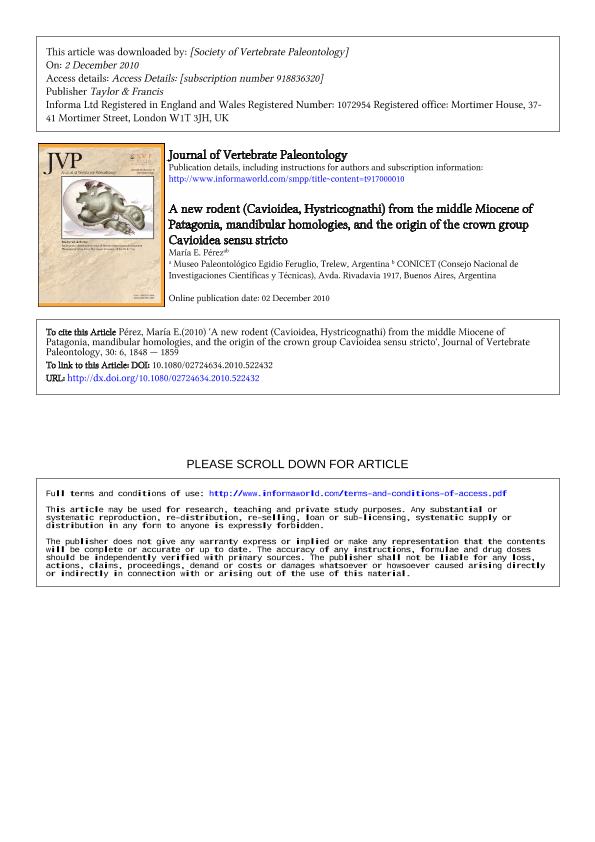Mostrar el registro sencillo del ítem
dc.contributor.author
Pérez, María Encarnación

dc.date.available
2019-09-23T17:50:28Z
dc.date.issued
2010-11
dc.identifier.citation
Pérez, María Encarnación; A new rodent (Cavioidea, Hystricognathi) from the middle Miocene of Patagonia, mandibular homologies, and the origin of the crown group Cavioidea sensu stricto; Society of Vertebrate Paleontology; Journal of Vertebrate Paleontology; 30; 6; 11-2010; 1848-1859
dc.identifier.issn
0272-4634
dc.identifier.uri
http://hdl.handle.net/11336/84154
dc.description.abstract
Cavioidea sensu stricto groups three traditionally recognized families that are characterized by hypsodont, double-heart-shaped cheek teeth and moderate hystricognathy: Eocardiidae, Caviidae, and Hydrochoeridae. Eocardiidae was erected to include a diverse assemblage of extinct and plesiomorphic taxa, whereas Caviidae and Hydrochoeridae (the crown group of Cavioidea) include the lineages with extant representatives (cuyes, maras, and capybaras). A new genus and species of Cavioidea sensu stricto, Guiomys unica, is described here from the middle Miocene of west central Patagonia (Argentina). The new taxon is known from mandibular and maxillary fragments with molars, and isolated cheek teeth. A phylogenetic analysis of Cavioidea sensu stricto shows G. unica as the sister taxon of the clade formed by the crown group of Cavioidea sensu stricto ('medialis series'). The new species displays characters states intermediate between eocardiids and the 'medialis series.' The most outstanding character of Guiomys unica is the autapomorphic position of the notch for the insertion of the masseter medialis pars infraorbitalis muscle, isolated from both the masseteric and horizontal crests. This notch is located at the anterior end of the masseteric crest in eocardiids and represents the plesiomorphic state for Cavioidea sensu stricto. In caviids and hydrochoerids, the notch is located at the anterior end of the horizontal crest, the derived state for this character. G. unica allows reinterpretation of the homologies of the mandibular crests in basal cavioids and clarifies the evolutionary origins of crown-group cavioids (Caviidae + Hydrochoeridae).
dc.format
application/pdf
dc.language.iso
eng
dc.publisher
Society of Vertebrate Paleontology

dc.rights
info:eu-repo/semantics/openAccess
dc.rights.uri
https://creativecommons.org/licenses/by-nc-sa/2.5/ar/
dc.subject
Cavioidea
dc.subject
Miocene
dc.subject
South America
dc.subject
Patagonia
dc.subject.classification
Paleontología

dc.subject.classification
Ciencias de la Tierra y relacionadas con el Medio Ambiente

dc.subject.classification
CIENCIAS NATURALES Y EXACTAS

dc.title
A new rodent (Cavioidea, Hystricognathi) from the middle Miocene of Patagonia, mandibular homologies, and the origin of the crown group Cavioidea sensu stricto
dc.type
info:eu-repo/semantics/article
dc.type
info:ar-repo/semantics/artículo
dc.type
info:eu-repo/semantics/publishedVersion
dc.date.updated
2019-09-20T15:11:05Z
dc.journal.volume
30
dc.journal.number
6
dc.journal.pagination
1848-1859
dc.journal.pais
Estados Unidos

dc.journal.ciudad
Lawrence
dc.description.fil
Fil: Pérez, María Encarnación. Museo Paleontológico Egidio Feruglio; Argentina. Consejo Nacional de Investigaciones Científicas y Técnicas; Argentina
dc.journal.title
Journal of Vertebrate Paleontology

dc.relation.alternativeid
info:eu-repo/semantics/altIdentifier/doi/http://dx.doi.org/10.1080/02724634.2010.522432
dc.relation.alternativeid
info:eu-repo/semantics/altIdentifier/url/https://www.tandfonline.com/doi/abs/10.1080/02724634.2010.522432
Archivos asociados
